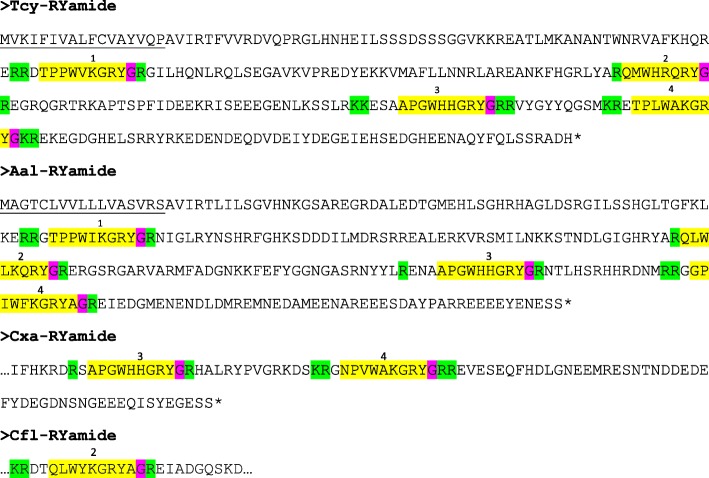Fig. 5.
Amino acid sequences of the RYamide preprohormones from T. cystophora, A. alata, C. xayamacana, and C. fleckeri. Residues and peptide sequences are highlighted as in Fig. 1. These preprohormones can be processed in a number of neuropeptides with the C-terminal RYamide sequences. Just like the LWamide preprohormones (Fig. 3), it is possible to group these peptides into four peptide subfamilies which, interestingly, are positioned at discrete locations on the medusa RYamide preprohormones (Table 3). At positions-1 (counted from the N- to the C-terminus) the the T. cystophora and A. alatina preprohormones contain two nearly identical RYamide neuropeptides (TPPWVKGRYamide, respectively TPPWIKGRYamide; see also Table 3). At positions-2 (counted from the N- to the C-terminus) the T. cystophora, A. alatina, and C. fleckeri preprohormones contained three highly similar neuropeptides, which in T. cystophora has the sequence pQMWHRQRYamide (see also Table 3). At positions-3 (counted from the N- to C-terminus), the preprohormones from T. cystophora, A. alata, and C. xaymacana each contains an identical neuropeptide with the sequence APGWHHGRYamide (see also Table 3). At positions-4, the preprohormones from T. cystophora, A. alata, and C. xaymacana contain sequences of closely related peptides of which the one in T. cystophora has the sequence TPLWAKGRYamide (see also Table 3). The four neuropeptide subfamilies have structural signatures (Table 3), which enable us to assign a peptide-3 (belonging to the third peptide subfamily) and a peptide-4 (belonging to the fourth peptide subfamily) on the preprohormone fragment from C. xaymacana and a peptide-2 (belonging to the second peptide subfamily) on the small preprohormone fragment from C. fleckeri

